Yellow flowers are a stunning and vibrant addition to any garden or floral arrangement. They are known for their cheerful and sunny appearance, which makes them a popular choice for many occasions, including weddings, birthdays, and even funerals. Yellow flowers come in a wide variety of shapes and sizes, and they can be found in many different species of plants.
One of the most popular types of yellow flowers is the sunflower, which is known for its large and bold appearance. These flowers can grow to be several feet tall, and they are often used in gardens and as cut flowers in bouquets. Sunflowers are also important crops, as they are used to produce cooking oil and birdseed.
Another popular yellow flower is the daffodil, which is commonly associated with spring. These flowers have a distinctive trumpet shape and can range in color from pale yellow to bright gold. Daffodils are often used in gardens and as cut flowers, and they are also a symbol of hope and new beginnings.
Other yellow flowers include the buttercup, marigold, and yellow rose. Each of these flowers has its own unique qualities and meanings, making them a great choice for a variety of occasions. Buttercups are known for their delicate appearance and can often be found growing wild in meadows and fields. Marigolds are often used in landscaping and as border plants, and they are also known for their medicinal properties. Yellow roses are a symbol of friendship, and they are often given as a gift to show appreciation for someone’s kindness.
Want to learn all flower’s name? this blog will help you to find all the flower’s names in English and all language as well.
Type of Flower - Color
| Flowers Type | |
| White Flowers Name | Blue Flowers Name |
| Yellow Flowers Name | Pink Flowers Name |
| Purple Flowers Name | Red Flowers Name |
31 Yellow Flowers Name List

#1. DAHLIA
Dahlia is a beautiful flowering plant that belongs to the family Asteraceae, which includes daisies, sunflowers, and chrysanthemums. The plant is native to Central America, Colombia, and Mexico and was named after the famous Swedish botanist Anders Dahl.
- Scientific name: Cosmos bipinnatus
- Plant type: Annual flowering plant
- Sunlight needs: Full sun
- Plant size: Typically grows to be 1-6 feet tall and 1-3 feet wide
- Growing zones: Typically grows best in zones 2-11, although specific varieties may have different requirements
- Soil needs: Prefers well-drained soil that is neutral to slightly acidic, although it can tolerate a wide range of soil types
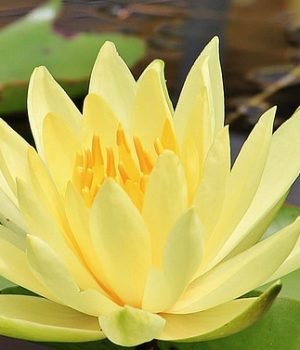
#2. WATER LILy
Water Lily is a popular aquatic flowering plant that belongs to the family Nymphaeaceae. It is known for its beautiful and fragrant flowers that float on the surface of still waters like ponds,
- Scientific name: Nymphaea
- Plant type: Aquatic perennial
- Sunlight needs: Full sun to partial shade
- Plant size: Water Lilies can grow up to 6 inches to 6 feet in height, depending on the variety. The leaves can range from 3 inches to 3 feet in diameter.
- Growing zones: Water Lilies can grow in USDA hardiness zones 3-11, depending on the variety.
- Soil needs: Water Lilies require a rich, loamy soil that is high in organic matter. They grow best in a soil mixture that is specifically designed for aquatic plants and should be planted in pots that are placed on the bottom of the pond.
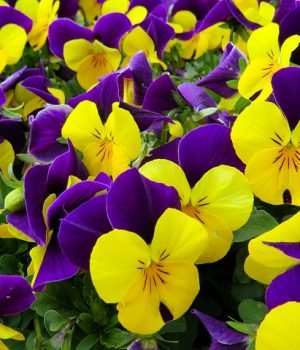
#3. PANSY
Sure, here’s an article on Pansy flowers that includes the information you requested presented in bullet point format
- Scientific Name: Viola tricolor var. hortensis
- Plant Type: Herbaceous flowering plant
- Sunlight Needs: Pansies prefer full or partial sun, but can also grow in shade.
- Plant Size: Pansies typically grow to be 6-9 inches tall and 9-12 inches wide.
- Growing Zones: Pansies are hardy in zones 4-8 but can be grown as annuals in warmer climates.
- Soil Needs: Pansies prefer well-draining soil with a slightly acidic pH between 5.4 and 5.8. They also prefer soil that is rich in organic matter.
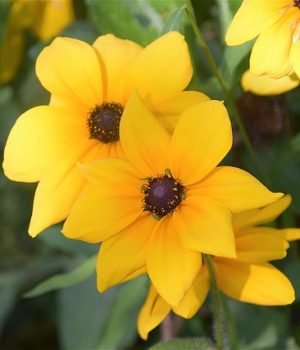
#4. BLACK-EYED SUSAN
Black-Eyed Susans are known for their bright yellow petals and dark brown centers They are popular for use in borders, mass plantings, and wildflower gardens.
- Scientific Name: Rudbeckia hirta
- Plant Type: Herbaceous perennial flowering plant
- Sunlight Needs: Black-Eyed Susans prefer full sun to partial shade, ideally around 6 hours of direct sunlight per day.
- Plant Size: Black-Eyed Susans typically grow to be 1 to 3 feet tall and 1 to 2 feet wide.
- Growing Zones: Black-Eyed Susans are hardy in zones 3 through 9, though they may need some protection in colder climates.
- Soil Needs: Black-Eyed Susans prefer well-draining soil that is rich in organic matter. They can tolerate a range of soil types, but prefer slightly acidic soil with a pH between 5.5 and 7.0.

#5. Yellow carnation
Sure, here’s an article about yellow carnation flowers that includes scientific names, plant type, sunlight needs, plant size, growing zones, and soil needs in bullet points:
- Scientific name: Dianthus caryophyllus Plant type: Herbaceous perennial
- Sunlight needs:
- Full sun to partial shade
- At least 6 hours of direct sunlight per day
Plant size:
- Height: 18-24 inches (45-60 cm)
- Width: 12-18 inches (30-45 cm)
Growing zones:
- USDA hardiness zones 5-9
- Can grow as an annual in cooler climates
Soil needs:
- Well-draining soil
- Neutral to slightly alkaline pH (6.0-7.5)
- High in organic matter
- Care tips:
- Water regularly, but avoid overwatering
- Fertilize every 4-6 weeks during the growing season
- Deadhead spent blooms to promote new growth
- Mulch around the base of the plant to retain moisture and suppress weeds
- Prune back in the fall to promote healthy growth the following seas

#6. LOTUS FLOWEr
Lotus flowers are iconic symbols of purity and enlightenment in many cultures around the world. They are also beautiful aquatic plants that can be grown in ponds and water gardens.
- Sunlight Needs: Lotus flowers prefer full sunlight and need at least 6 hours of direct sunlight each day to produce the best blooms. They can tolerate some shade, but too much shade can result in fewer flowers.
- Plant Size: Lotus plants can grow up to 6 feet (1.8 meters) tall and spread up to 10 feet (3 meters) wide. They have large leaves and showy flowers that can range in color from white, pink, to red.
- Growing Zones: Lotus flowers are hardy in USDA growing zones 4 to 11. They are aquatic plants and require a pond or water garden to grow. The water in which they grow should be at least 2-3 feet (60-90 cm) deep and have good circulation.
- Soil Needs: Lotus flowers prefer well-draining soil that is rich in organic matter. They are heavy feeders and require a lot of nutrients to grow and bloom. Adding compost or other organic matter to the soil can help improve its fertility and drainage.

#7. YELLOW ZINNIA
Sure, here’s an article about Yellow Zinnia flowers that includes their scientific name, plant type, sunlight needs, plant size, growing zones, and soil needs in bullet points:
- Scientific Name: Zantedeschia aethiopica
- Plant Type: Calla Lily is a perennial plant that grows from a bulb and can reach a height of up to 3 feet (90 cm). It is often grown as a potted plant, but can also be grown outdoors in mild climates.
- Sunlight Needs: Calla Lily prefers bright, indirect sunlight or partial shade. It can tolerate some direct sunlight, but too much can damage the leaves and flowers.
- Plant Size: The size of the Calla Lily plant can vary depending on the cultivar and growing conditions, but on average it grows to be about 1-3 feet (30-90 cm) tall and 1-2 feet (30-60 cm) wide.
- Growing Zones: Calla Lily is hardy in USDA growing zones 8-10. It is native to southern Africa, but has been widely cultivated in many regions of the world.
- Soil Needs: Calla Lily prefers well-draining soil that is rich in organic matter. It can tolerate a range of soil types, but does best in soil that is slightly acidic to neutral (pH 6.0-7.0).

#8. MARIGOLD
Marigolds are beautiful and popular flowers that can be found in gardens and landscapes all around the world. They are easy to grow and care for, making them a great choice for novice gardeners.
- Sunlight Needs: Marigolds prefer full sunlight and need at least 6 hours of direct sunlight each day to produce the best blooms. They can tolerate some shade, but too much shade can result in fewer flowers.
- Plant Size: Marigold plants can grow up to 1-4 feet (30-120 cm) tall and spread up to 1-2 feet (30-60 cm) wide. They have small, compact flowers that come in a variety of colors, including yellow, orange, and red.
- Growing Zones: Marigolds are hardy in USDA growing zones 2 to 11. They are relatively low-maintenance plants and can be grown in both gardens and containers.
- Soil Needs: Marigolds prefer well-draining soil that is rich in organic matter. They are not heavy feeders and do not require a lot of nutrients to grow and bloom. Adding compost or other organic matter to the soil can help improve its fertility and drainage.

#9. YARROW
Yarrow is a hardy and versatile perennial flower that is prized for its delicate, fern-like foliage and clusters of small, colorful flowers.
- Scientific Name: Achillea millefolium
- Plant Type: Herbaceous perennial
- Sunlight Needs: Yarrow prefers full sunlight and can tolerate some partial shade. They need at least 6 hours of direct sunlight each day to produce the best blooms.
- Plant Size: Yarrow plants can grow up to 2-4 feet (60-120 cm) tall and spread up to 1-2 feet (30-60 cm) wide. They have small, flat-topped flowers that come in a variety of colors, including yellow, pink, and white.
- Growing Zones: Yarrow is hardy in USDA growing zones 3 to 9. They are low-maintenance plants and can be grown in both gardens and containers.
- Soil Needs: Yarrow prefers well-draining soil that is not too rich in nutrients. They can tolerate a wide range of soil types, including sandy, loamy, and clay soils. However, they do not like wet or waterlogged soil, so be sure to plant them in a spot with good drainage.

#10. DAFFODILS
Sure, here’s an article on Daffodil flowers that includes the information you requested presented in bullet point format
- Scientific Name: Narcissus spp.
- Plant Type: Herbaceous perennial flowering plant
- Sunlight Needs: Daffodils prefer full sun to partial shade.
- Plant Size: Daffodils can grow to be 6 to 24 inches tall, depending on the variety.
- Growing Zones: Daffodils are hardy in zones 3 through 9.
- Soil Needs: Daffodils prefer well-draining soil that is rich in organic matter. They can tolerate a range of soil types, but prefer slightly acidic to neutral soil with a pH between 6.0 and 7.0.

#11. Pasque Flower
Pasque flowers are a stunning early-blooming perennial plant that is known for their vibrant colors and delicate beauty.
- Sunlight Needs: Pasque flowers prefer full to partial sunlight and can tolerate some shade. They need at least 6 hours of direct sunlight each day to produce the best blooms.
- Plant Size: Pasque flowers can grow up to 12 inches (30 cm) tall and spread up to 12 inches (30 cm) wide. They have feathery leaves and showy flowers that can range in color from blue, purple, pink, to white.
- Growing Zones: Pasque flowers are native to North America and can grow in USDA hardiness zones 3 to 8. They are well-suited to grow in rocky, well-draining soils in the prairies and alpine regions.
- Soil Needs: Pasque flowers thrive in well-draining soil that is sandy or loamy. They are tolerant of a wide range of pH levels and can even grow in slightly acidic soils. They do not tolerate wet or heavy soils and can rot in these conditions.

#12. PRIMROSE
Primrose flowers are known for their bright, delicate blooms in shades of pink, purple, white, and yellow.
- Scientific Name: Primula vulgaris
- Plant Type: Herbaceous perennial flowering plant
- Sunlight Needs: Primroses prefer partial shade to full shade.
- Plant Size: Primroses can grow to be 6 to 12 inches tall and 6 to 8 inches wide, depending on the variety.
- Growing Zones: Primroses are hardy in zones 4 through 8.
- Soil Needs: Primroses prefer well-draining soil that is rich in organic matter. They prefer slightly acidic to neutral soil with a pH between 6.0 and 7.0.

#13. IRIS
Iris flowers are known for their beautiful, showy blooms in a wide variety of colors, including blue, purple, pink, yellow, and white.They are popular for use in mixed borders
- Scientific Name: Iris spp.
- Plant Type: Herbaceous perennial flowering plant
- Sunlight Needs: Iris flowers prefer full sun to partial shade.
- Plant Size: Iris plants can grow to be 6 inches to 4 feet tall and 6 inches to 2 feet wide, depending on the variety.
- Growing Zones: Iris flowers are hardy in zones 3 through 10, depending on the variety.
- Soil Needs: Iris prefer well-draining soil that is slightly acidic to neutral. They prefer soil with a pH between 6.0 and 7.5.
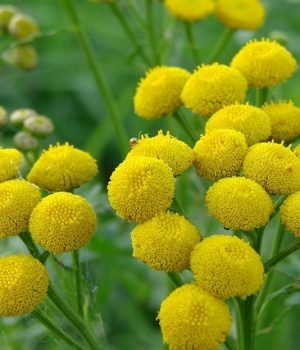
#14. TANSY
Tansy flowers are known for their bright yellow button-like blooms that appear in dense clusters.They are popular for use in cottage gardens, mixed borders, and as cut flowers
- Scientific Name: Tanacetum vulgare
- Plant Type: Herbaceous perennial flowering plant
- Sunlight Needs: Tansy flowers prefer full sun to partial shade.
- Plant Size: Tansy plants can grow to be 2 to 3 feet tall and 1 to 2 feet wide.
- Growing Zones: Tansy flowers are hardy in zones 4 through 9.
- Soil Needs: Tansy prefers well-draining soil that is moderately fertile. They prefer soil with a pH between 6.0 and 7.0

#15. GOLDENROD
Goldenrod flowers are known for their bright yellow, fluffy plumes that appear in late summer and early fall.They are popular for use in wildflower gardens, meadows, and as cut flowers
Scientific Name: Lupinus
- Plant Type: Lupine is a herbaceous perennial plant that is grown for its showy, spiky flowers.
- Sunlight Needs: Lupine prefers full sunlight to partial shade.
- Plant Size: The size of the Lupine plant can vary depending on the cultivar and growing conditions, but on average it grows to be about 1-4 feet (30-120 cm) tall and 1-3 feet (30-90 cm) wide.
- Growing Zones: Lupine is hardy in USDA growing zones 3-9, depending on the cultivar. It is native to North America, Europe, and Asia.
- Soil Needs: Lupine prefers well-draining soil that is slightly acidic to neutral (pH 6.0-7.0). It is a nitrogen-fixing plant, meaning it can convert atmospheric nitrogen into a form that can be used by other plants.

#16. SUNFLOWERS
Sunflowers are beloved for their bright yellow petals and impressive size. Their scientific name is Helianthus annuus, which accurately describes their sun-loving nature and large, bright blooms.
- Sunflowers (Scientific Name: Helianthus annuus).
- Sunlight Needs: Sunflowers thrive in full sunlight, which means they need at least 6 hours of direct sunlight each day. They are not shade-tolerant, so make sure to plant them in a spot that receives plenty of sun. Sunflowers are often planted in fields where they can receive full sun all day long.
- Plant Size: Sunflowers can grow quite tall, with some varieties reaching heights of up to 16 feet (4.9 meters). The size of the flower heads can also vary, with some measuring as small as 2 inches (5 cm) in diameter and others growing up to 1 foot (30 cm) wide.
- Growing Zones: Sunflowers are annual plants and can grow in a wide range of growing zones, from Zone 1 to Zone 11. They are adaptable to different climates and can withstand a variety of temperatures.
- Soil Needs: Sunflowers prefer well-draining soil that is rich in nutrients. They can tolerate a range of soil types, including sandy, loamy, and clay soils, as long as the soil is not too wet or compacted. Adding compost or other organic matter to the soil can help improve its fertility and drainage.
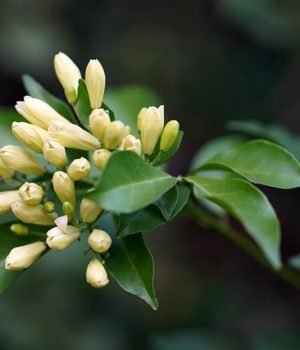
#17. Jessamine
Jessamine flowers are known for their fragrant, white or yellow blooms, which can add a sweet scent to any garden or landscape. They are a popular choice for climbers, covering trellises and walls with their foliage and flowers.
- Scientific name: Jasminum
- Plant type: Woody vine or shrub
- Sunlight needs: Full sun to partial shade
- Plant size: Can range from small shrubs to climbing vines up to 30 feet in length
- Growing zones: Depending on the specific species, Jessamine Flowers can grow in zones 6-11
- Soil needs: Well-draining soil that is consistently moist, but not waterlogged. Jessamine Flowers can tolerate a wide range of soil types, including sandy or clay soils.

#18 Daisy
Daisy flowers are a popular choice for gardeners, thanks to their charming, white or pink petals and bright yellow centers. Here are some of the key features and requirements of this plant:
- Scientific name: Bellis perennis
- Plant type: Herbaceous perennial
- Sunlight needs: Full sun to partial shade
- Plant size: Typically grows 6-12 inches tall and 6-9 inches wide, but can grow up to 3 feet tall under ideal conditions
- Growing zones: Daisy Flowers can grow in zones 4-8
- Soil needs: Well-draining soil that is consistently moist. Daisies prefer slightly acidic to neutral soil with a pH between 6.0 and 7.0. They can tolerate a range of soil types, including clay and sandy soils.
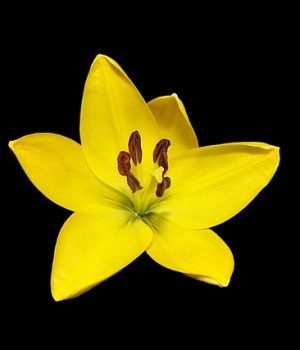
#19. Daylily
Daylilies are a popular perennial plant known for their vibrant and colorful flowers.
- Scientific name: Hemerocallis
- Plant type: Herbaceous perennial
- Sunlight needs: Full sun to partial shade
- Plant size: Typically grows 1-4 feet tall and 1-3 feet wide, but can vary depending on the cultivar
- Growing zones: Daylilies can grow in zones 3-9
- Soil needs: Well-draining soil that is consistently moist. Daylilies prefer slightly acidic to neutral soil with a pH between 6.0 and 7.0. They can tolerate a range of soil types, including clay and sandy soils.

#20. Coreopsis
Coreopsis flowers are known for their bright yellow or golden blooms, which have a daisy-like appearance. Some cultivars may have red or pink flowers. They bloom from early summer to fall and are attractive to pollinators like bees and butterflies.
- Scientific name: Coreopsis
- Plant type: Herbaceous perennial
- Sunlight needs: Full sun to partial shade
- Plant size: Typically grows 1-4 feet tall and 1-3 feet wide, but can vary depending on the cultivar
- Growing zones: Coreopsis can grow in zones 4-9
- Soil needs: Well-draining soil that is consistently moist. Coreopsis prefer slightly acidic to neutral soil with a pH between 6.0 and 7.0. They can tolerate a range of soil types, including clay and sandy soils.

#21.Blanket flower
Blanket Flowers are known for their bright, daisy-like flowers with red, yellow, and orange petals. Some cultivars may have bicolor flowers with red or orange petals and a yellow center.
- Scientific name: Gaillardia
- Plant type: Herbaceous perennial
- Sunlight needs: Blanket Flowers prefer full sun, but can tolerate some shade.
- Plant size: Depending on the cultivar, Blanket Flowers can grow up to 3 feet tall and spread up to 2 feet wide.
- Growing zones: Blanket Flowers can grow in zones 3-10, depending on the specific species. Some species are more cold-hardy, while others prefer warmer temperatures.
- Soil needs: Blanket Flowers prefer well-draining soil that is consistently moist. They can tolerate a range of soil types, from sandy to clay soils. However, they do best in slightly acidic to neutral soil with a pH between 6.0 and 7.0.
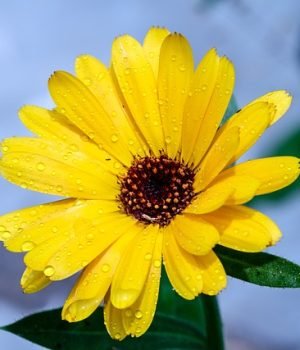
#22.Calendula
Calendula, also known as pot marigold, is a beautiful and versatile flowering plant that is easy to grow and care for.
- Sunlight Needs: Calendula prefers full sunlight but can also tolerate partial shade. They need at least 6 hours of direct sunlight each day to produce the best blooms.
- Plant Size: Calendula can grow up to 2 feet (60 cm) tall and spread up to 1.5 feet (45 cm) wide. They have bright, daisy-like flowers that can range in color from yellow, orange, to red.
- Growing Zones: Calendula is an annual plant that is hardy in USDA growing zones 2 to 11. They are easy to grow and can be planted directly in the ground or in containers.
- Soil Needs: Calendula prefers well-draining soil that is rich in organic matter. They can tolerate a range of soil types, from sandy to loamy soils, as long as the soil is not too wet or compacted. Adding compost or other organic matter to the soil can help improve its fertility and drainage.
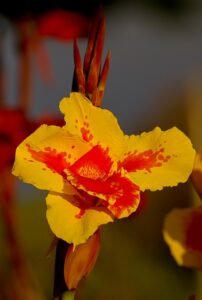
#23. Canna Lily
Canna Lily is a stunning flowering plant that is prized for its showy blooms and lush foliage. It is a tropical plant that can add a touch of the exotic to any garden or container.
- Scientific Name: Canna indica
- Plant Type: Perennial flowering plant
- Sunlight Needs: Canna Lily prefers full sunlight and can tolerate some partial shade. They need at least 6 hours of direct sunlight each day to produce the best blooms.
- Plant Size: Canna Lily plants can grow up to 3-8 feet (0.9-2.4 meters) tall and spread up to 1-3 feet (0.3-0.9 meters) wide. They have large, tropical-looking leaves and showy flowers that come in a variety of colors, including red, orange, yellow, and pink.
- Growing Zones: Canna Lily is hardy in USDA growing zones 7 to 11. They are low-maintenance plants and can be grown in both gardens and containers.
- Soil Needs: Canna Lily prefers well-draining soil that is rich in organic matter. They can tolerate a wide range of soil types, including sandy, loamy, and clay soils. However, they do not like wet or waterlogged soil, so be sure to plant them in a spot with good drainage.
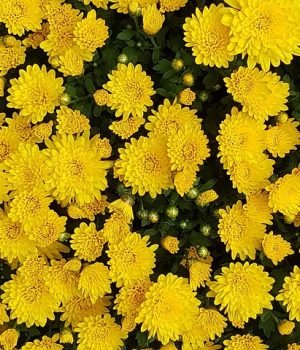
#24.Chrysanthemum
Chrysanthemums are known for their showy, daisy-like flowers, which come in a wide range of colors and forms. They bloom from late summer to fall and are attractive to bees and butterflies.
- Scientific name: Chrysanthemum spp.
- Plant type: Herbaceous perennial or annual, depending on the species and cultivar
- Sunlight needs: Chrysanthemums prefer full sun, but can tolerate some shade. However, they will flower best in full sun.
- Plant size: Depending on the species and cultivar, Chrysanthemums can grow from 1 to 6 feet tall and spread up to 3 feet wide.
- Growing zones: Chrysanthemums can grow in a wide range of zones, depending on the species and cultivar. Some are cold-hardy and can be grown in zones 3-9, while others prefer warmer temperatures and can be grown in zones 7-10.
- Soil needs: Chrysanthemums prefer well-draining soil that is consistently moist. They can tolerate a range of soil types, from sandy to clay soils. However, they do best in slightly acidic to neutral soil with a pH between 6.0 and 7.0.
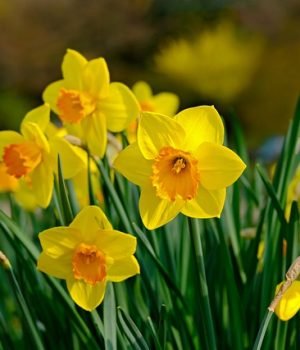
#25. Daffodil
Daffodils are known for their cheerful, trumpet-shaped flowers, which come in a range of colors including yellow, white, orange, and pink. They bloom in the early spring and are one of the first flowers
- Scientific name: Narcissus spp.
- Plant type: Herbaceous perennial
- Sunlight needs: Daffodils prefer full sun to partial shade. They will flower best in full sun, but can tolerate some shade.
- Plant size: Depending on the species and cultivar, Daffodils can grow from 6 inches to 2 feet tall and spread up to 6 inches wide.
- Growing zones: Daffodils can grow in zones 3-8, depending on the species and cultivar. They are cold-hardy and can tolerate freezing temperatures.
- Soil needs: Daffodils prefer well-draining soil that is consistently moist. They can tolerate a range of soil types, from sandy to clay soils. However, they do best in slightly acidic to neutral soil with a pH between 6.0 and 7.0.

26. Daisy
Daisies are known for their simple, white or yellow petals with a yellow center. They bloom in the late spring to summer and attract butterflies and bees to the garden.
- Scientific name: Bellis perennis
- Plant type: Herbaceous perennial or annual, depending on the variety
- Sunlight needs: Daisies prefer full sun to partial shade. They will flower best in full sun, but can tolerate some shade.
- Plant size: Depending on the variety, Daisies can grow from 6 inches to 2 feet tall and spread up to 1 foot wide.
- Growing zones: Daisies can grow in a wide range of zones, from 4 to 9 depending on the variety. Some varieties are cold-hardy and can be grown in zones 4-8, while others prefer warmer temperatures and can be grown in zones 7-9.
- Soil needs: Daisies prefer well-draining soil that is consistently moist. They can tolerate a range of soil types, from sandy to clay soils. However, they do best in slightly acidic to neutral soil with a pH between 6.0 and 7.0.
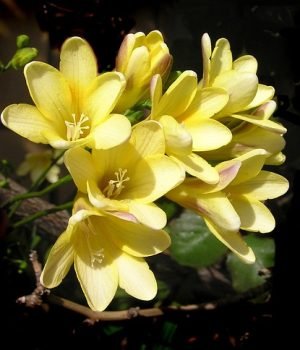
#27.Freesia
Freesias are known for their fragrant, funnel-shaped flowers that come in a range of colors, including white, yellow, orange, pink, and red. They bloom in the late winter to spring and are often used
- Scientific name: Freesia spp.
- Plant type: Herbaceous perennial
- Sunlight needs: Freesias prefer full sun to partial shade. They will flower best in full sun, but can tolerate some shade.
- Plant size: Freesias can grow from 6 inches to 2 feet tall and spread up to 6 inches wide, depending on the variety.
- Growing zones: Freesias are native to South Africa and are typically grown as annuals in most parts of the United States. They can be grown in zones 9-11, or as indoor plants in cooler climates.
- Soil needs: Freesias prefer well-draining soil that is consistently moist. They can tolerate a range of soil types, from sandy to loamy soils. However, they do best in slightly acidic to neutral soil with a pH between 6.0 and 7.0.

#28.Goldenrod
Goldenrod is known for its bright yellow flowers that bloom in the late summer to fall. The flowers are arranged in clusters that can be up to a foot long. Goldenrod is often used in naturalistic
- Scientific name: Solidago spp.
- Plant type: Herbaceous perennial
- Sunlight needs: Goldenrod prefers full sun to partial shade. They will flower best in full sun, but can tolerate some shade.
- Plant size: Goldenrod can grow from 1 to 7 feet tall and up to 3 feet wide, depending on the variety.
- Growing zones: Goldenrod is native to North America and is found throughout most of the United States. They can be grown in zones 3-9.
- Soil needs: Goldenrod prefers well-draining soil that is rich in organic matter. They can tolerate a range of soil types, from sandy to loamy soils. However, they do best in slightly acidic to neutral soil with a pH between 6.0 and 7.5.
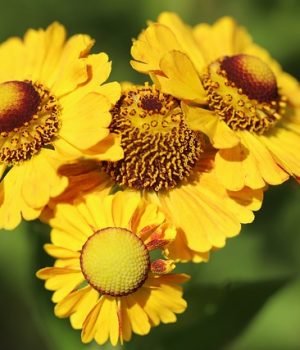
#29.Hellebores
Hellebores are known for their elegant, cup-shaped flowers that come in a range of colors, including white, pink, red, purple, and green. The flowers typically bloom in late winter or early sprinSc
- Scientific name: Helleborus spp.
- Plant type: Herbaceous perennial
- Sunlight needs: Hellebores prefer partial to full shade. They can tolerate some morning sun, but too much direct sunlight can scorch their leaves.
- Plant size: Hellebores typically grow to be 1 to 2 feet tall and wide, depending on the variety.
- Growing zones: Hellebores are native to Europe and Asia and can be grown in zones 4-9.
- Soil needs: Hellebores prefer well-draining soil that is rich in organic matter. They can tolerate a range of soil types, from sandy to clay soils. However, they do best in slightly acidic to neutral soil with a pH between 6.0 and 7.5.
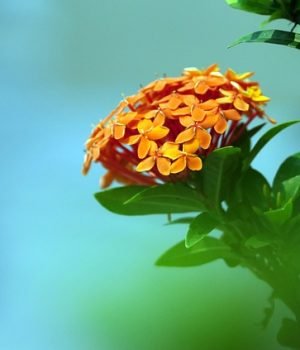
#30.Jungle Geranium
Jungle Geraniums are known for their brightly colored, star-shaped flowers that bloom in clusters. The flowers come in a range of colors, including red, orange, pink, and yellow.
- Scientific name: Ixora spp.
- Plant type: Evergreen shrub or small tree
- Sunlight needs: Jungle Geraniums prefer full sun to partial shade. They need at least 6 hours of direct sunlight per day to thrive.
- Plant size: Jungle Geraniums can range in size from small shrubs to small trees, depending on the variety. They typically grow 3-6 feet tall and wide.
- Growing zones: Jungle Geraniums are native to tropical and subtropical regions and can be grown in zones 10-11.
- Soil needs: Jungle Geraniums prefer well-draining, slightly acidic soil that is rich in organic matter. They can tolerate a range of soil types, from sandy to clay soils, but do best in soil that is kept consistently moist.
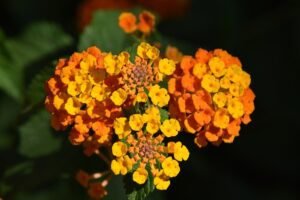
#31.Lantana
Lantana flowers are known for their clusters of small, brightly colored blooms that are often multicolored. The flowers come in shades of red, orange, yellow, pink, and purple,
- Scientific name: Lantana camara
- Plant type: Perennial shrub or groundcover
- Sunlight needs: Lantana flowers thrive in full sun to partial shade. They need at least 6 hours of direct sunlight per day to bloom profusely.
- Plant size: Lantana plants can range in size from low-growing groundcovers to small shrubs, depending on the variety. They typically grow 1-6 feet tall and wide.
- Growing zones: Lantana is native to tropical and subtropical regions and can be grown in zones 8-11. It can also be grown as an annual in cooler regions.
- Soil needs: Lantana prefers well-draining soil that is rich in organic matter. It can tolerate a range of soil types, from sandy to clay soils, but does best in soil that is kept consistently moist.
120 Yellow Flowers With Their Names

